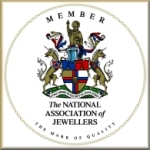Choosing A Gem
There are several things to consider when buying a coloured gem. Unlike diamonds, there is no set criteria by which to grade coloured gems. There are however certain points to consider when buying any coloured gem.

Colour ...
Your choice of colour is of primary importance. Every coloured gemstone will come in a variety of shades and hues and each of us have our own personal preference. The colour of a gem is one of the most important factors when determining the value of a gem. There is no real fixed bench mark by which you can determine the best colour for a coloured gem but some colours are more popular than others. For instance, the top colour for ruby is often described as 'pigeon blood'. This term has been much abused over the years and it is common to see rubies in a variety of shades being described as 'pigeon blood'.

Cut ...
Another important consideration to take into account is the cut of a gem. There are many different methods and styles of cutting gems, often unique to the country in which they were cut. Gemstones can often be cut in a variety of cuts but the most common shapes are oval, round, cushion & octagon. Some gems are cut as a cabochon, which is basically a polished dome cut. This type of cut is suitable for many gems which have an optical effect like opal or stones with stars or cat's eyes. The cabochon cut is also used of opaque or semi-translucent gemstones. Many gems can also be faceted. To facet a gem the lapidary will determine the best angles to cut the gem and the correct orientation of the gem. This requires great skill as the overall appearance of the gem can be greatly affected by the cutting process. Once the gem has been orientated to its best position, the lapidary will then pre-form the rough gem into its ideal shape, then grind and polish a series of facets into the gem. The facets will act as mirrors in the gem and reflect the light which shines into the gem. The reflected light will bounce around inside the gem creating the sparkling effect or brilliance.
Weight ...
All gemstones are sold by weight. The unit used to weigh gems is known as a carat with 5 carats being equal to a gram. Some types of gemstones are commonly found in large sizes whereas others are rarely found in sizes over one carat. Large sized gem-quality rubies are very rare and can be extremely expensive. With rarer gems like rubies, the price per carat can climb rapidly once the stone's weight goes over a carat.

Inclusions ...
The inclusions in gemstones are often mistakenly referred to as 'flaws'. This could be no further from the truth, as anyone who has seen a gem in a microscope will confirm. The inclusions in a gem can reveal its natural origin amongst many other things. The size and location of the inclusion can have an effect on the gem's value. Interesting inclusions which are discreetly located can sometimes enhance a gem's value. Obviously, large inclusions directly under the table should be avoided.
Budget ...
Finally, you should consider your budget when choosing your gem. The price of coloured gems can vary from tens of pounds to millions of pounds. There are many different gems available to suit all budgets. We have tourmalines starting from around £50 per carat (+VAT) up to very fine rubies and sapphires which can command thousands per carat. At TopGem.co.uk we have available a wide variety of many different types of gems in all kinds of colours for you to choose from.




